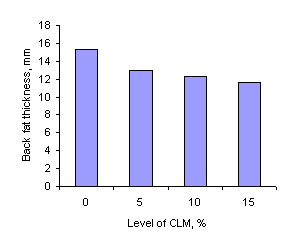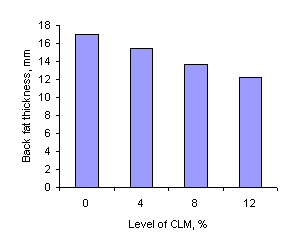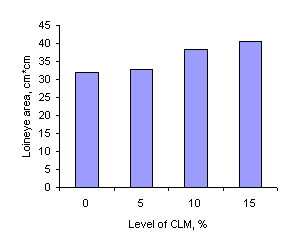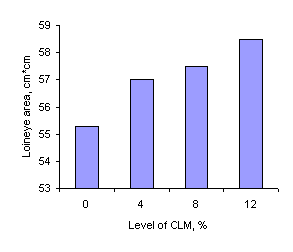Effects of inclusion of different levels of cassava
leaf meal in the diet on the performance of growing-finishing
pigs
Bui Huy Nhu Phuc and Brian Ogle*
University of Agriculture and Forestry, HoChiMinh City.
Vietnam
bphuc.ldanh@hcm.fpt.vn
*Swedish University of Agricultural Science, Uppsala, Sweden
Abstract
Two experiments were done on inclusion of cassava leaf meal
(CLM) in the diets for growing fishing pigs.
The daily weight gains (DWG) were
846, 804, 801 and 770 g/day for CLM0, CLM5, CLM10 and CLM15,
respectively, and the corresponding feed conversion ratios (FCR)
were 2.58, 2.73 2.73 and 2.95 kg feed / kg gain, respectively. The back fat thickness decreased and the loin eye area
increased with CLM inclusion level.
In Experiment 2, 156 Yorkshire x Duroc x Landrace pigs at 60
days of age with initial weight of 23 ± 0.3 kg were raised to 90 kg. They
were randomly allocated into 4 treatments, with inclusion of
cassava leaf meal (CLM) in the diets of 0, 4, 8 and 12 %, replacing rice bran
(w/w). The live weight gains were slightly improved with
increasing CLM inclusion level, and were 545, 572, 547 and 569
g/day (P>0.05) for CLM0, CLM4, CLM8, and CLM12, respectively. FCR was
slightly higher at the highest inclusion level (3.24, 3.24, 3.27 and 3.33 kg feed / kg gain, respectively).
Back fat thickness decreased and there was an increased protein
content, but lower lipid content of loin eye muscle in the CLM fed
groups.
It is concluded that it is possible to include up to 12% of CLM
in the diet of growing finishing pigs without detrimental
effects
Keywords: cassava leaf meal, growing-finishing
pigs, HCN.
Introduction
Under tropical conditions there is often an abundance of
energy-rich feedstuffs with low fiber content, while conventional
protein-rich feeds are less available. Thus, the use of forages
with high protein content could offer an attractive possibility for
the improvement of the dietary protein supply.
Cassava is one of the main crops in the tropical countries.
Cassava leaf is considered as a by-product at root harvest
(Ravindran and Rajaguru 1988) and yields may be as high as 4.6 tonnes dry matter (DM) per ha. Numerous reports have shown that
cassava leaf meal (CLM) has a high but variable protein content
(170 to 400 g/kg CP on a dry matter basis). In recent years several
studies have done on the nutritive values of cassava leaves, such
as digestibility, nitrogen retention, and preservation methods (Bui
van Chinh and Le Viet Ly 2001; Bui Huy Nhu Phuc et al 2001). The results
showed that it may have the potential to be used as a source of
feed in low fiber diets for pigs and sun drying could be a good
method for their preservation, as it can reduce HCN by up to 90 %
of the level in the fresh leaves (Phuc and Lindberg 2000). As the capacity of
the pig to digest fibrous components improves as the pig matures (Kennelly and
Aherne 1980) this strategy would be beneficial
for the nutrient supply to pigs.
It is necessary to determine the extent to which CLM can
contribute to the supply of nutrients for animals, as well as their
nutritional limitations, especially anti-nutritional factors. The aim of this
study was to determine the optimum inclusion level of
cassava leaf meal in diets for growing-finishing
pigs.
Materials and methods
Two experiments were done on growing finishing pigs.
Experimental design
Experiment 1:
The trial was a complete randomized block design, with 32 hybrid
(Yorkshire x Duroc x Landrace) pigs at 65 days of age, and average
initial weight of 28 kg. To eliminate genetic effects, the pigs
were selected from 8 litters, and randomly allocated into 4
treatments. Each treatment included 8 pigs with equal numbers of
males and females in each treatment.
The animals were kept in individual pens with concrete floors and
there were 8 pens per treatment.
Experiment 2:
The trial was a complete randomized block design, and was
carried out at an industrial pig farm. 156 Yorkshire x Duroc x Landrace pigs at
60 days of age and average initial weight of 23
± 0.3 kg were used. The pigs were randomly divided into 4
treatments, with 39 pigs per treatment (20 males and 19 females).
The animals were kept on concrete floors, with three pens per
treatment and 15-20 pigs per pen.
Diets
Experiment 1.
Four inclusion levels of cassava leaf meal: 0, 5,
10 and 15 % replaced a basal diet to give treatments CLM0, CLM5,
CLM10 and CLM15, respectively.
Experiment 2.
Four inclusion levels of cassava leaf meal: 0, 4,
8 and 12 % of CLM (based on DM) replaced rice bran to give
treatments CLM0, CLM4, CLM8 and CLM12, respectively. The basal
diets included maize meal , rice bran, soybean meal, fish meal and
a mineral-vitamin supplement. Cassava root meal was also used in
experiment 2 as the energy source.
The feed ingredients and the chemical composition are recorded
in Tables 1 and 2 for experiment 1 and 2, respectively. Cassava
leaves were harvested at root harvesting and sun dried for 2 days.
The leaves were ground to pass a 1mm screen before mixing with the
other ingredients. Pigs were fed 3 times per days at 07.00h, 11.00h
and 16.00 h. There was free access to water from nipple drinkers.
Observations
Performance of the growing pigs in both experiments was
evaluated with respect to body weight, feed conversion ratio (FCR),
and the health of animals. At the end of the experiment, 3 pigs
per treatment in experiment 1 and 2 pigs per treatment in
experiment 2 were slaughtered to measure carcass quality. Samples
of loin eye muscle were analyzed for chemical composition
Chemical analysis
Feed and meat were analyzed for dry matter (DM), determined by
drying at 105oC to a constant weight. Ether extract
(EE) and crude protein (CP) (Nx6.25) were determined according to AOAC (1998). The energy and amino acid contents of the diets were
calculated from the tables.
Statistical analysis
The General Linear Model of Minitab Statistical Software
Version 13 (2001) was used. Sources of variation were treatments and error. Linear regression analysis of the
effect of level inclusion on daily gain and feed conversion ratio
was performed.
Results
Diets
The chemical composition of the diets in experiment 1 showed
that the replacement of the basal diet by CLM reduced the ME
content of the diets in proportion to increasing inclusion level.
The reduction was 191 kcal at the highest level (15% CLM) (from
3059 to 2868 kcal/kg) in experiment 1 but the reduction in ME
content was much lower in experiment 2 (25 kcal at the highest
level of CLM inclusion of 12%). CP content was similar among
treatments in experiment 1, while there was increasing CP with inclusion levels of CLM in experiment 2, due to the fact that CLM has a higher CP
content than rice bran. The fiber content of the diets increased
with increasing CLM inclusion level in both experiments, especially
at the highest level of inclusion. The difference compared to the
basal diet and the diet with the highest CLM inclusion was around 1
percentage unit in experiment 1, but only 0.5 percentage units in
experiment 2. Other nutrients were not much different among the
diets (Tables 1 and Table 2)
|
Table 1. Feed ingredient and chemical composition of experimental diets inExperiment 1 (% air dry) |
||||
|
|
CLM0 |
CLM5 |
CLM10 |
CLM15 |
|
Maize |
531 |
515 |
500 |
483 |
|
Rice bran |
260 |
230 |
200 |
170 |
|
Cassava leaf meal |
0 |
50 |
100 |
150 |
|
Soybean meal |
150 |
145 |
140 |
137 |
|
Fish meal |
40 |
40 |
40 |
40 |
|
Lysine |
1.5 |
1.5 |
1.5 |
1.5 |
|
Limestone |
6.9 |
6.9 |
6.9 |
6.9 |
|
Salt |
5 |
5 |
5 |
5 |
|
Dicalcium phosphate |
3.8 |
3.8 |
3.8 |
3.8 |
|
Premix |
3 |
3 |
3 |
3 |
|
Total |
1000 |
1000 |
1000 |
1000 |
|
Chemical composition |
|
|
|
|
|
ME (kcal/kg) |
3059 |
3024 |
2994 |
2868 |
|
Protein (%) |
16.1 |
16.2 |
16.1 |
16.5 |
|
Fiber (%) |
4.50 |
5.04 |
5.28 |
5.55 |
|
Lysine |
0.9 |
0.93 |
0.95 |
0.98 |
|
P |
0.62 |
0.63 |
0.62 |
0.61 |
|
Ca |
0.62 |
0.67 |
0.72 |
0.78 |
|
Table 2. Feed ingredients and chemical composition of diets in experiment 2 |
||||
|
|
CLM0 |
CLM4 |
CLM8 |
CLM12 |
|
Maize |
490 |
491 |
493 |
495 |
|
Cassava root meal |
50 |
50 |
50 |
50 |
|
Rice bran |
247 |
207 |
167 |
127 |
|
Cassava leaf meal |
0 |
40 |
80 |
120 |
|
Soybean meal |
137.3 |
136.3 |
134.3 |
132.3 |
|
Fish meal |
50 |
50 |
50 |
50 |
|
Lysine |
0.4 |
0.6 |
0.6 |
0.6 |
|
Oyster shell |
13 |
13 |
13 |
13 |
|
Salt |
4 |
4 |
4 |
4 |
|
Monocalcium phosphate |
5.8 |
5.8 |
5.8 |
5.8 |
|
Premix |
2.5 |
2.5 |
2.5 |
2.5 |
|
Total |
1000 |
1000 |
1000 |
1000 |
|
ME (kcal/kg) |
3049 |
3040 |
3032 |
3024 |
|
Protein (%) |
16.23 |
16.57 |
16.84 |
17.11 |
|
Crude fiber (%) |
4.75 |
4.86 |
4.97 |
5.08 |
|
Lysine (%) |
0.90 |
0.93 |
0.95 |
0.97 |
|
P (%) |
0.67 |
0.66 |
0.64 |
0.62 |
|
Ca (%) |
0.78 |
0.82 |
0.86 |
0.9 |
Effects of inclusion level of CLM on pig
performance
Experiment 1.
The inclusion of CLM in the diets reduced DWG of the pigs by from 5 to 9% compared to the control group while FCR increased from 5 to 14% (Table 3).
|
Table 3. Effects of inclusion level of CLM in the diet on the performance of growing finishing pigs (Experiment 1) |
|||||
|
|
CLM0 |
CLM5 |
CLM10 |
CLM15 |
SEM |
|
No of pigs |
8 |
8 |
8 |
8 |
|
|
Initial weight , kg |
27.5 |
28.2 |
28.3 |
28.5 |
0.94 |
|
Final weight, kg |
94.3 |
91.8 |
91.6 |
89.4 |
1.90 |
|
DWG, g/day |
846 |
804 |
801 |
770 |
20.5 |
|
FCR, kg feed/kg gain |
2.58 |
2.72 |
2.73 |
2.95 |
0.09 |
|
Feed intake, kg/day |
2.18 |
2.18 |
2.18 |
2.27 |
0.07 |
Experiment 2:
In contrast with the results above, the results of experiment 2 showed that the DWG tended to improve with the inclusion of CLM (by around 4 to 5%) but there were no significant differences among treatments (P>0.05) (Table 4). FCR was similar for the control group and the group fed the diet with 4% CLM. There was a slight increase of FCR with increasing inclusion level of CLM at higher levels. It was 1% for CLM8 and 3% for CLM12.
|
Table 4. Effects of inclusion level of CLM in the diets on the performance of growing finishing pigs (Experiment 2) |
|||||
|
|
CLM0 |
CLM4 |
CLM8 |
CLM12 |
SEM |
|
No of pigs |
39 |
39 |
39 |
39 |
|
|
Initial weight, kg |
23.0 |
23.0 |
23.0 |
23.0 |
0.34 |
|
Final weight, kg |
84.0 |
87.0 |
85.0 |
87.0 |
1.69 |
|
DWG, g/day |
545 |
572 |
548 |
570 |
15.6 |
|
FCR |
3.24 |
3.24 |
3.27 |
3.33 |
0.09 |
|
Feed intake, kg/day |
1.76 |
1.85 |
1.80 |
1.90 |
0.09 |
Effects of inclusion level of CLM on carcass quality
In both experiments (Tables 5 and 6), the back fat decreased (Figures 1a and 1b) and the loin eye area (Figure 2a and 2b) increased as the level of CLM was increased Figure 1). There was no apparent effect of CLM inclusion level on the chemical composition of the meat (Tables 5 and 6).
|
Table 5. Effects of inclusion level of CLM on carcass quality (Experiment 1) |
|||||
|
|
CLM0 |
CLM5 |
CLM10 |
CLM15 |
SEM |
|
Carcass dressing % |
76.0 |
76.4 |
75.4 |
76.0 |
2.39 |
|
Loin eye area (cm 2) |
31.9 |
32.9 |
38.3 |
40.6 |
3.7 |
|
Back fat thickness (mm) |
15.3 |
13.0 |
12.3 |
11.6 |
1.65 |
|
Chemical composition of meat (%) |
|
|
|
|
|
|
Dry matter |
27.5 |
27.5 |
28.0 |
28.2 |
0.62 |
|
Protein |
25.0 |
24.4 |
25.2 |
25.0 |
0.49 |
|
Lipid |
2.07 |
2.18 |
2.31 |
2.23 |
0.14 |
|
Table 6. Effects of inclusion level of CLM on carcass quality (Experiment 2) |
||||||
|
|
CLM0 |
CLM4 |
CLM8 |
CLM12 |
SEM |
|
|
Carcass dressing % |
77.6 |
79.1 |
78.6 |
79.4 |
2.7 |
|
|
Back fat thickness (mm) |
17.0 |
15.5 |
13.7 |
12.2 |
1.4 |
|
|
Loin eye area (cm2) |
55.3 |
57.0 |
57.5 |
58.5 |
4.5 |
|
|
Chemical composition of meat (%) |
|
|
|
|
||
|
DM |
28.4 |
27.1 |
26.6 |
26.6 |
0.95 |
|
|
Protein |
21.9 |
23.3 |
22.6 |
22.6 |
0.53 |
|
|
Lipid |
3.6 |
3.4 |
3.7 |
3.1 |
0.99 |
|
 |
 |
|
Figure 1a. Effect of inclusion of CLM in
the diet on backfat |
Figure 1b. Effect of inclusion of CLM in the diet on backfat thickness (experiment 2) |
 |
 |
|
Figure 2a. Effect of inclusion of CLM in
the diet |
Figure 2b. Effect of inclusion of CLM in the diet on loin eye area (experiment 2) |
Discussion
The differences in response to CLM inclusion in the two experiments is probably a reflection of the of the changes in nutrient composition due the addition of the supplement . In experiment 1, the CLM replaced the basal diet, which was of higher nutritive value than the CLM, whereas in experiment 2, the cassava leaf meal replaced rice bran which was probably of slightly inferior composition compared with the CLM. The first results is in line with other studies on the rat, as well as on growing pigs (Phuc et al. 2000, Phuc and Lindberg 2000).
There were no significant differences in live weight
gain in both
experiments. This means that the inclusion level of CLM can be up
to 12-15 % in the diet without negative effects on growth rate. These
results are in accord with other studies on fattening pigs with
9-13% ensiled cassava leaves in the diet, where there were no
significant effects on performance up to 11% in the diet (Du Thanh Hang et al
1997) or up to15% (Nguyen Thi Loc1996).
The amounts of feed
consumed were not different among treatments in both experiments,
indicating that there was no effect on feed intake, and
palatability with the inclusion levels studied. This indicates that
effects of HCN or tannin on feed intake were small at the
levels used.
There were no indications of cyanide toxicity on any of the diets in the present study. It can be concluded that sun drying is a good processing method in eliminating the deleterious effects of HCN and to make CLM safe for animals. This result is in accord with results on rats, as well as on pigs reported by Phuc et al (2000).
The results show that to use CLM for pigs efficiently, it is
necessary to identify the diet. Up to 15 % of CLM can be used in
the diet without problem. However, the optimum level is from 4 to
10 %, depending on factors such as the basal diet, prices and the
availability of the leaves.
The fact that pigs fed CLM had a bigger loin eye area and
lower back fat thickness in both experiments may be the result of the leaves having
a good amino acid profile.
Conclusions
-
Cassava leaf meal can be used in fattening pig diets without any negative effects.
-
It can be a source of benefit to farmers, especially if replacing a high fiber feed such as rice bran or coconut meal.
-
Farmers have to make a decision as to what should be replaced and at what level of inclusion.
-
From the results of this study the optimum level of cassava leaf meal is from 4 to 10 % in the diet.
References
AOAC 1998 Official methods of analysis,
Association of Official Analytical Chemists, 13th edn.
Washington DC.
Bui Huy Nhu Phuc, Ogle B and Lindberg
J K 2001
Nutritive value of cassava leaves for monogastric animals.
International Workshop "Current Research and Development on use of
Cassava as Animal Feed". p 31-40.
Bui van Chinh and Le Viet Ly 2001. Studies on the
processing and use of cassava top as animal feed. International
WORKSHOP Current Research and Development on use of Cassava as
Animal Feed.p:91-96.
Du Thanh Hang, Nguyen van Lai, Rodriguez Lylian and Ly J 1997 Nitrogen digestion and metabolism in Mong cai pigs fed sugar cane juice and different foliages as source of protein. Livestock Research for Rural Development 9(2). http://www.cipav.org.co/lrrd/lrrd9/2/hang92.htm
Kennelly J J and Aherne F
X 1980 The effect of fibre in diets formulated to contain different levels of energy and
protein on digestibility coefficients in swine. Can. J. Anim. Sci.
60,717-726.
Minitab Statistical Software version 12 1998. User's
guide to statistic. Minitab Inc., USA
Nguyen Thi Loc 1996
On-farm and on-station evaluation
of cassava root silage for fattening pigs in Central Vietnam. MSc.
Thesis, Swedish University of Agricultural Sciences.
Phuc B H N and
Lindberg J E 2000 Ileal and total
tract digestibility in growing pigs fed cassava root meal diets
with inclusion of cassava leaves, leucaena leaves and groundnut
foliage.
www.bsas.org.uk/Publications/
Phuc B H N, Ogle B
and Lindberg J E 2000 Effect of
replacing soybean meal with cassava leaf protein in cassava root
meal based diets for growing pigs on digestibility and N retention.
Anim. Feed Sci. Technol. 83: 223-235.
Ravindran V and Rajaguru A S
B
1988 Effect of stem pruning on cassava root yield and leaf growth.
Sri Lanka. J. Agric. Sci. 25(2): 32-37.
Ravindran V 1990 Cassava leaf meal. In: Thacker,
P A., Kirkwood, R N (Eds). Non-traditional Feed Souces for Use in
swine production. Butterworths, Boston. pp. 91-101.